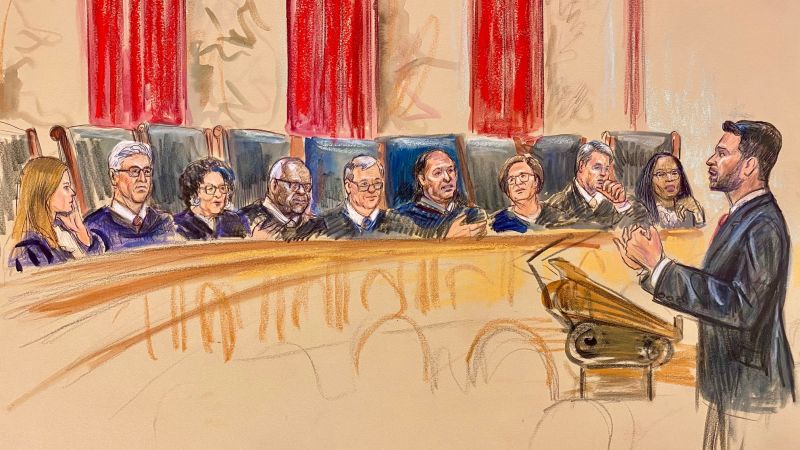As the U.S. Supreme Court enters a highly contentious phase of its annual session, the justices are revealing their policy preferences and underlying grievances more openly than ever. This trend is particularly striking in the context of recent opinions where individual justices have taken the opportunity to express broader political concerns alongside their legal reasoning. While disputes and differing ideological views have always been part of the Court’s fabric, the current climate seems to amplify these divergences, potentially impacting public perception of the judiciary’s impartiality.
A notable instance of this occurred when Justice Brett Kavanaugh, while delivering excerpts from a recent decision regarding environmental regulations, made a passionate declaration about the government’s delays. He emphasized the detrimental effects of bureaucratic lag on crucial infrastructure projects, stating that “delay upon delay” leads to fewer, more expensive railroads, airports, and other important constructs. Kavanaugh’s comments reflected a broader critique of government inefficiency and suggested economic repercussions, such as job losses stemming from stalled infrastructure projects. This merging of policy critique with judicial opinion signals a willingness among justices to engage in a more politically charged dialogue.
Similarly, Justice Clarence Thomas contributed to this narrative when he signed a separate opinion related to a unanimous ruling on job bias, including a footnote that attacked initiatives promoting diversity, equity, and inclusion (DEI). Citing views from the America First Legal Foundation, which was founded by Stephen Miller, a prominent figure during the Trump administration, he expressed concern that such initiatives lead to discrimination against majority groups. This opinion not only underscored ideological divides but also highlighted the influence of external political agendas on judicial decisions.
Meanwhile, Justice Ketanji Brown Jackson dissented in a case allowing the Department of Government Efficiency (DOGE) access to Social Security data, drawing stark contrasts between the conservative majority’s rapid decisions and lower court judges’ more measured approaches. Jackson praised the careful work of lower court judges while critiquing her colleagues for acting hastily, likening their approach to “fanning the flames” of controversy rather than resolving issues. Her criticisms indicated a notable tension between progressive and conservative viewpoints in the Court, particularly surrounding matters related to Trump’s litigation during and after his presidency.
Even amidst these discussions, Chief Justice John Roberts has consistently maintained that the Court should act as neutral arbiters of the law, rather than political actors echoing societal consequences. However, the current trend of integrating political discourse into court opinions raises questions about the judicial branch’s supposed non-partisanship and the implications of such behaviors on the rule of law.
As the Court approaches its traditional June deadline for ruling on significant cases, disputes regarding state bans on medical care for transgender youth and challenges to birthright citizenship are at the forefront of public interest and societal discourse. The ruling outcomes could pose broader implications for various marginalized communities and affect legislative discussions across the country.
The ideological rift among the justices, particularly between the appointments made by Republican and Democratic presidents, is increasingly apparent. Conservative justices such as Roberts, Thomas, Gorsuch, Kavanaugh, Alito, and Barrett often find alignment in their rulings compared to the liberal bloc represented by Jackson, Sonia Sotomayor, and Elena Kagan.
This factional divide was observable in a recent ruling concerning former President Trump’s attempt to dismiss agency heads of independent bodies like the National Labor Relations Board. The discourse surrounding this case captured widespread attention due to its potential impacts on the Federal Reserve and economic stability. If Trump were allowed to remove leaders from these independent entities, it raised significant questions about the integrity of monetary policy and the autonomy of federal institutions.
In response to Trump’s criticisms of Federal Reserve Chair Jerome Powell, who he accused of being overly cautious regarding interest rates, the Court’s majority seemed to temper its ruling by specifically exempting the Fed from Trump’s reach. This decision appeared to be more about placating the political atmosphere than strictly adhering to established legal precedents, as Justice Kagan pointed out in her dissent.
Kagan characterized the majority’s decision as a favoring of the President’s interests over judicial precedent, referencing a long-standing case that highlighted limitations on presidential authority over independent agencies. She posited that a more traditional judicial response would have sufficed in addressing market concerns without creating complex exceptions that further muddle the rule of law.
In sum, the current Supreme Court is navigating a landscape where legal opinions are increasingly interwoven with political commentary, encapsulating the passionate, divisive feelings that characterize American society today. With critical cases ahead and a divided court poised to rule, the interplay of ideology, law, and its implications for governance remains a focal point for both legal scholars and the public alike.



